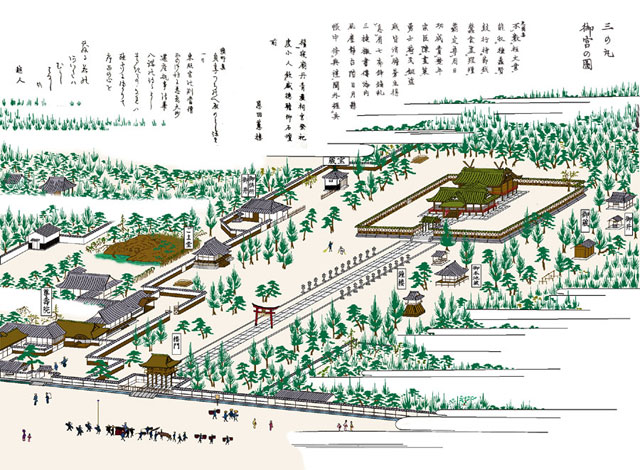Nagoya Tōshō-gū on:
[Wikipedia]
[Google]
[Amazon]
is a

Homepage of Nagoya Tōshō-gū
Shinto shrines in Nagoya Nagoya Castle Buildings and structures in Japan destroyed during World War II Religious buildings and structures completed in 1651 Tōshō-gū Aichi Prefecture designated tangible cultural property {{Shinto-shrine-stub
Shinto shrine
A Stuart D. B. Picken, 1994. p. xxiii is a structure whose main purpose is to house ("enshrine") one or more kami, , the deities of the Shinto religion.
The Also called the . is where a shrine's patron is or are enshrined.Iwanami Japanese dic ...
located in central Nagoya
is the largest city in the Chūbu region of Japan. It is the list of cities in Japan, fourth-most populous city in Japan, with a population of 2.3million in 2020, and the principal city of the Chūkyō metropolitan area, which is the List of ...
, Aichi Prefecture
is a Prefectures of Japan, prefecture of Japan located in the Chūbu region of Honshū. Aichi Prefecture has a population of 7,461,111 () and a geographic area of with a population density of . Aichi Prefecture borders Mie Prefecture to the ...
, Japan
Japan is an island country in East Asia. Located in the Pacific Ocean off the northeast coast of the Asia, Asian mainland, it is bordered on the west by the Sea of Japan and extends from the Sea of Okhotsk in the north to the East China Sea ...
.
History

Tōshō-gū
A is a Shinto shrine in which Tokugawa Ieyasu (1543–1616), the founder of the Tokugawa shogunate, is enshrined. List of Tōshō-gū, Tōshō-gūs are found throughout Japan.
The most well-known Tōshō-gū is the Nikkō Tōshō-gū located i ...
is dedicated to Tokugawa Ieyasu
Tokugawa Ieyasu (born Matsudaira Takechiyo; 31 January 1543 – 1 June 1616) was the founder and first ''shōgun'' of the Tokugawa shogunate of Japan, which ruled from 1603 until the Meiji Restoration in 1868. He was the third of the three "Gr ...
, the founder of the Tokugawa shogunate
The Tokugawa shogunate, also known as the was the military government of Japan during the Edo period from 1603 to 1868.
The Tokugawa shogunate was established by Tokugawa Ieyasu after victory at the Battle of Sekigahara, ending the civil wars ...
. It was built in 1619 (Genna 5) on the orders of Lord Tokugawa Yoshinao
was a Japanese ''daimyō'' of the early Edo period.
Biography
Born the ninth son of Tokugawa Ieyasu with his concubine, Okame no Kata. His childhood name was Gorōtamaru (五郎太丸). While still a young child, he was appointed leader ...
of Owari, two years after the construction of Nikkō Tōshō-gū
is a Tōshō-gū Shinto shrine located in Nikkō, Tochigi Prefecture, Japan.
Together with Futarasan Shrine and Rinnō-ji, it forms the Shrines and Temples of Nikkō UNESCO World Heritage Site, with 42 structures of the shrine included in the ...
. It was located outside Nagoya Castle
is a Japanese castle located in Nagoya, Japan.
Nagoya Castle was constructed by the Owari Domain in 1612 during the Edo period on the site of an earlier castle of the Oda clan in the Sengoku period. Nagoya Castle was the heart of one of the ...
in the Sannomaru enceinte, next to the ''Tennosha'' (today's Nagoya Shrine).
The Nagoya Tōshō-gū Festival was the biggest festival in Nagoya before the Second World War.
The shrine was moved from the Sannomaru enceinte of Nagoya Castle to its present location in the late 19th century. The original main hall burned during the air raids of the Pacific War
The Pacific War, sometimes called the Asia–Pacific War or the Pacific Theatre, was the Theater (warfare), theatre of World War II fought between the Empire of Japan and the Allies of World War II, Allies in East Asia, East and Southeast As ...
. The present main hall was a mausoleum for Lord Yoshinao's consort Haruhime (春姫), which used to be located at Kenchū-ji
Kenchū-ji (建中寺) is a Jōdo-shū Buddhist temple in Tsutsui, Higashi-ku, Nagoya, central Japan. Starting in the Edo period, the mausoleums of the lords of the Owari Domain were located there, making it the ''Bodaiji
A in Japanese Buddhi ...
temple, and was moved to the site in 1953 as a replacement. It is a designated cultural property of Aichi prefecture.
A model of the old shrine's main hall is kept at the Engineering Faculty of Tokyo University.
References
External links
Homepage of Nagoya Tōshō-gū
Shinto shrines in Nagoya Nagoya Castle Buildings and structures in Japan destroyed during World War II Religious buildings and structures completed in 1651 Tōshō-gū Aichi Prefecture designated tangible cultural property {{Shinto-shrine-stub